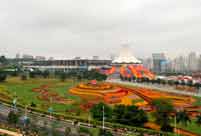Motor vehicles in Beijing consume more than 7 million tons of fuel annually, discharging about 900,000 tons of emissions every year, municipal environmental authorities said on Tuesday.
The capital currently has 5.35 million vehicles, which consume over 4 million tons of gasoline and more than 2 million tons of diesel annually, said Li Kunsheng, an official in charge of vehicle emission management with the Beijing Municipal Environmental Protection Bureau.
The annual vehicle emission load is about 900,000 tons and contains 77,000 tons of hydrocarbons and over 80,000 tons of nitrogen oxides, according to Li.
"Vehicle emissions have been proven to contain over 100 kinds of carcinogenic substances. Even worse, the emissions are discharged at low altitudes, which may affect people's health more directly," Li said.
Cars in the city are considered major polluters in Beijing, with its number keeps growing.
A report by a research team from the Chinese Academy of Sciences revealed that vehicle exhaust has beaten industrial emission to become Beijing's top sources of air pollution, contributing to 22.2 percent of PM 2.5 particles.
PM 2.5 particles are airborne particles measuring less than 2.5 microns in diameter that caused hazardous smog earlier this year.
Li said that it is difficult for Beijing's emissions to diffuse because the city is surrounded by mountains, and emission reduction should be the first consideration when the city government strives to improve air quality in the often smog-shrouded city.
Beijing unveiled a package of anti-pollution measures earlier this month, including cutting vehicle emissions and curbing industrial pollution.
The package is part of an action plan released by the municipal government, which has pledged to reduce PM 2.5 density by 25 percent or more by 2017.
 DPRK holds military parade to mark 65th founding anniv.
DPRK holds military parade to mark 65th founding anniv. Highlights of MAKS 2013 Int'l Aviation and Space Show
Highlights of MAKS 2013 Int'l Aviation and Space Show  10th China-ASEAN Expo opens in Nanning
10th China-ASEAN Expo opens in Nanning Eagle Boy takes to sky to break another record
Eagle Boy takes to sky to break another record 12-year-old boy becomes pillar of the family
12-year-old boy becomes pillar of the family Eye-gouged boy receives blind rehabilitation in Shanxi
Eye-gouged boy receives blind rehabilitation in Shanxi Top 10 naked hotels in the world
Top 10 naked hotels in the world The most gorgeous Chinese women in the eyes of foreigners
The most gorgeous Chinese women in the eyes of foreigners A collection of bizarre rooftop buildings around China
A collection of bizarre rooftop buildings around China Residences of the royal house of Savoy
Residences of the royal house of Savoy China's frigate 'Bengbu'in fire training
China's frigate 'Bengbu'in fire training Fresh students 'forced' to register in university independently
Fresh students 'forced' to register in university independently 2013 Taiwan Int'l Tourism Expo kicks off in Taipei
2013 Taiwan Int'l Tourism Expo kicks off in Taipei Photo story: Take a gap year
Photo story: Take a gap year Nokia's Global Headquarters: visiting a declining empire
Nokia's Global Headquarters: visiting a declining empireDay|Week|Month